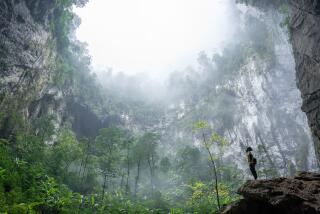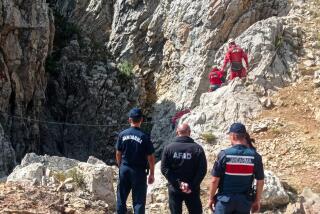Salamanders for Lunch: Underwater Exploration With the New Cave Men
- Share via
On a usual workday, Jeff Bozanic’s lunch date might be a primordial shrimp or a blind salamander. And although his is one of those enviable outdoor occupations, Bozanic is more likely to go home wrinkled than tanned.
Yet there are benefits to his job, said Bozanic, one of only a handful of underwater cave researchers in the country. The large-framed 28-year-old from Costa Mesa enjoys a phantasmagorical working environment that was inaccessible to humans before advances in dive techniques and equipment were made during the past decade.
In absolute darkness, Bozanic swims through a kind of parfait made up of salt, brackish and fresh waters. So precisely delineated are the layers that the beam from Bozanic’s hand-held lamp bounces off them.
Cave researchers have surmised that the chemistry of this parfait resembles that of ancient oceans; accordingly, many of the creatures Bozanic meets at work--sponges, fish, shrimp--are thought by scientists to be remnant populations of animals that lived on Earth before the time of dinosaurs.
The new field of underwater cave exploration is yielding discoveries in biology, geology, hydrology and archeology (ancient humans sometimes used caves as burial sites).
Underwater Place Names
For being first to travel submerged tunnels, cave researchers get passages named after them in places where most people will never go--there’s a route called Bozanic’s Line in the Lucayan Cavern System in the Bahamas, the most extensive underwater cave system in the world.
From Engineering to Scuba Diving
Jeff Bozanic has collected a slew of degrees in fields such as international marketing, geology and environmental education at UCLA and Humboldt State University. He once thought he would become an engineer like his father, but then began scuba diving in Southern California waters.
When Bozanic became experienced enough to teach diving himself, a standard part of his pitch to students was that fringe aspects of the sport, such as cave diving, were “stupid and suicidal.”
Dry cavers--spelunkers who stay out of water--and open-water divers tend to agree that combining the sports of spelunking and scuba diving is foolhardy. The Sierra Club guidebook to spelunking starts its cave-diving chapter with this advice: “CAUTION: It would be difficult to find a mode of exploration more dangerous than cave diving.”
Said Bozanic: “Most of the people that die in caves don’t have proper training.” The Cave Diving Section of the National Speleological Society was formed in 1973 in response to the high rate of accidental death among recreational cave divers. The chapter instituted a training program designed to acquaint open water divers and dry cavers with the unique hazards of underwater caves. Bozanic said that among the 4,000 cave divers trained by chapter instructors, there has not been a single caving-related death.
Bozanic’s fellow scuba instructor, Dennis Williams, coaxed Bozanic into diving in the Lucayan Cavern in 1981. Bozanic had completed more than 400 open-water dives by this time. He had even dived at night by the light of the moon and phosphorescent plankton. But diving into a cave was entirely different.
Bozanic and Williams carried lights, but if the lamps failed, or if they became lost in the maze-like passages, their only method of finding the exit would be to follow a safety guideline installed by earlier divers.
The water was astoundingly clear. In some underwater caves, divers can see for 400 feet, Bozanic said, while 15- to 20-foot
visibility is the norm at Laguna Beach, a popular local dive spot.
But a carelessly placed fin that grazes the cave wall, or even a blast of air bubbles from a snorkel, could turn the visibility to zero instantly, as the layers of water mix with silt, Bozanic said. Divers have been killed when they entered a cave depending on good visibility to find their way out, only to become lost when the water was churned up, he said.
“I was more intrigued than frightened,” Bozanic said of that initial dive. “I remember coming out of there feeling like I’d been at Disneyland--or better.”
Bozanic spent the next months reorganizing his affairs so that he could spend most of his time in Florida, a paradise for cave divers. Soon he was making research dives in all the great underwater caves in the world--places like the Canary Islands, the Bahamas, Cozumel and Hawaii.
His dive partners, Dennis Williams and Jill Yager, had made a major scientific find in 1979 when they bagged a peculiar-looking little creature in the Lucayan Caverns. It turned out to be a previously unknown class of crustacean called Remipedia, the most primitive ever discovered. It’s nearest known relative is a fossil 450 million years old.
Remote-Area Research
The cave divers were increasingly called on to perform underwater research funded by the Smithsonian Institute, the National Science Foundation and other organizations. The three friends formed Island Caves Research Center based in Key Biscayne, Fla. Bozanic currently spends about half the year traveling to remote places as a professional cave diver; the rest of the time he operates his own business in Costa Mesa, consulting for marine-related industries.
Although cave-diving activity in this country is concentrated on the East Coast, cave divers can be found in a number of sea caves and caverns all along the West Coast and the Channel Islands, Bozanic said. Also in the West is Devils Hole, a large water-filled limestone cavern in Death Valley. It’s off-limits to all but research divers because the endangered pupfish lives there.
Bozanic and other volunteers for the National Speleological Society have installed warning signs underwater at the entrance to some caves. “DIVERS DIED HERE,” the signs say, and advise people not to proceed without proper training.
Instruction Urged
Bozanic urges that anyone tempted to explore a submerged cave with scuba gear first obtain instruction through the Cave Diving Section of the National Speleological Society (the section’s address is P.O. Box 950, Branford, Fla.).
For those who are not afraid of the dark, and not prone to claustrophobia, cave diving can appear deceptively simple, Bozanic said.
The danger is in becoming disoriented and not being able to find the way out, or in having equipment fail without enough reserve oxygen to take a diver back to the entrance of the cave.
One of the five rules cave divers follow: Always reserve a minimum of two-thirds of your air so that if a partner has a tank failure, you can both exit the cave by sharing a single air supply. The other rules: Carry a minimum of three lights, use a guideline, never dive below 130 feet and be trained in cave diving.
Because the environment is so unforgiving, cave researchers go heavily laden. Bozanic has carried as many as seven air tanks to travel up to a mile into a cave. He normally carries three or four regulators, plankton nets, equipment for sampling sediment and water, a thermometer, a couple of watches, plastic bags to collect animal specimens, a camera with strobes, a reel for laying line, compasses, and a white plastic pencil and slate to make notes while submerged.
Some dives last as long as 4 1/2 hours, so Bozanic also packs an underwater lunch, usually pudding in a squeeze tube. “You can eat candy bars, but you’ve got to eat them quickly,” he said. “Sandwiches don’t work out real well.”
More to Read
Sign up for Essential California
The most important California stories and recommendations in your inbox every morning.
You may occasionally receive promotional content from the Los Angeles Times.













